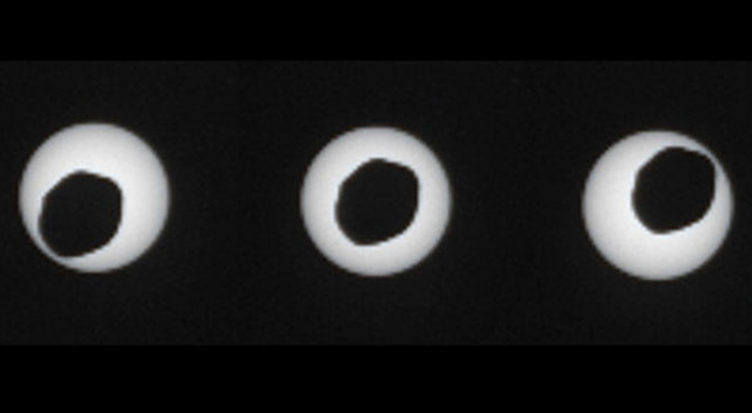
NASA's Curiosity rover has captured two stunning videos of solar eclipses from the surface of Mars, including one that shows the Red Planet's skies darkening dramatically above the 1-ton robot.
Curiosity recorded the two Mars solar eclipse videos on back-to-back days last month, Aug. 19 and Aug. 20. In both cases, Phobos — the larger of Mars' two tiny moons — blotted out much of the sun's disk.
Mission team members created the two eclipse videos, which NASA released Thursday (Sept. 5), by stitching together photos Curiosity snapped with its workhorse Mast Camera — 52 images for the Aug. 19 eclipse and 89 pictures for the event one day later. [Watch Curiosity's video of a solar eclipse shadow on Mars]
Phobos is just 14 miles (22 kilometers) wide on average, but it still manages to take a pretty big bite out of the sun during an eclipse seen from Mars. That's because the tiny satellite orbits very close to the Red Planet's surface — just 3,700 miles (6,000 kilometers) away.
For comparison, Earth's moon is about 2,160 miles (3,476 km) wide but zips around our planet at an average distance of 239,000 miles (384,600 km). That's just the right combination of size and distance to completely cover the sun's face, creating a total solar eclipse here on Earth when the alignment works out right.

Scientists think both Phobos and Mars' other minuscule satellite, Deimos, are former asteroids captured by the Red Planet's gravity long ago.
Phobos orbits Mars every eight hours, while the more farflung Deimos (average orbital distance: 12,470 miles, or 20,070 km) completes one lap every 30 hours or so. But neither moon will be in its current orbit forever; Deimos is speeding up, while Phobos is slowing down.
Get the Space.com Newsletter
Breaking space news, the latest updates on rocket launches, skywatching events and more!
Curiosity's eclipse observations should help refine scientists' understanding of the two moons' orbits, mission team members have said.
The Curiosity rover landed inside Mars' huge Gale Crater in August 2012 to determine if the Red Planet has ever been capable of supporting microbial life. In March, rover scientists announced that an area near the mission's landing site called Yellowknife Bay was indeed habitable billions of years ago.
Curiosity is now embarked on a long drive to the foothills of the towering Mount Sharp, whose many layers preserve a record of Mars' changing environmental history over time.
Follow Mike Wall on Twitter @michaeldwall and Google+. Follow us @Spacedotcom, Facebook or Google+. Originally published on SPACE.com.
Join our Space Forums to keep talking space on the latest missions, night sky and more! And if you have a news tip, correction or comment, let us know at: community@space.com.

Michael Wall is a Senior Space Writer with Space.com and joined the team in 2010. He primarily covers exoplanets, spaceflight and military space, but has been known to dabble in the space art beat. His book about the search for alien life, "Out There," was published on Nov. 13, 2018. Before becoming a science writer, Michael worked as a herpetologist and wildlife biologist. He has a Ph.D. in evolutionary biology from the University of Sydney, Australia, a bachelor's degree from the University of Arizona, and a graduate certificate in science writing from the University of California, Santa Cruz. To find out what his latest project is, you can follow Michael on Twitter.









